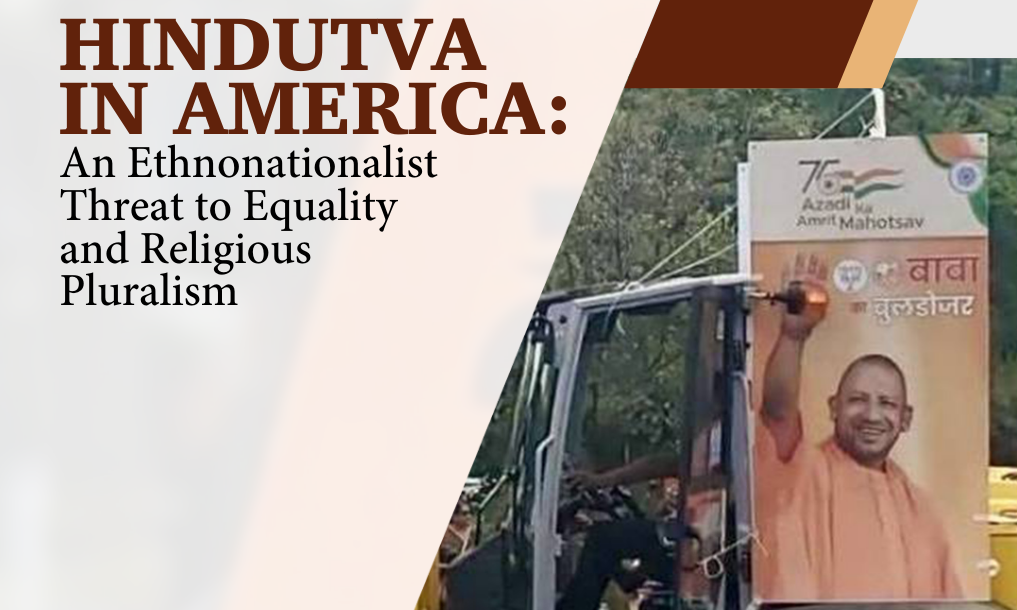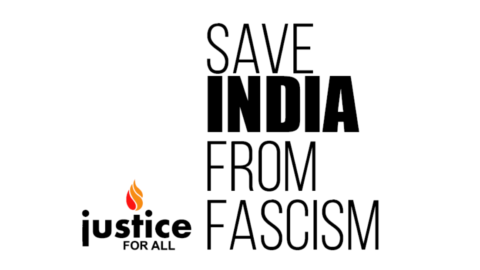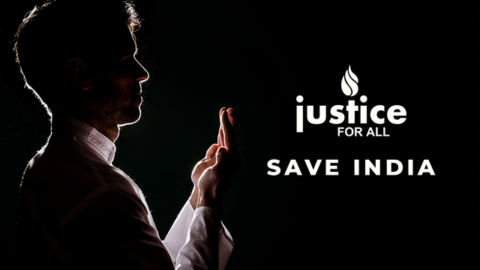August 18, 2025 Justice For All cautiously welcomes the U.S. State Department’s 2024 Human Rights…

HINDUTVA IN AMERICA: Rutgers Center for Security, Race and Rights – 2025 Report
The Rutgers Center for Security, Race and Rights report on the spread and effects of Hindutva in America.
The full report can be downloaded HERE
SUMMARY by Justice For All:
I. Introduction
A. Defining Hindutva
1. Distinct from Hinduism as a religion
2. Far right political ideology that “advocates for Hindu supremacy and seeks to transform India, constitutionally a secular state, into an ethno-religious nation known as the Hindu Rashtra (Hindu nation).”
B. Hindutva in America
1. Works against core American values by perpetuating supremacist ideas and discrimination
2. Active in the U.S. for over 50 years.
3. Promoted by segments of the South Asian diaspora, who align with other far-right ideologies like white supremacy, Zionism, and Islamophobia.
4. Opposition to Hindutva also exists within the South Asian American community; some proponents are not of South Asian descent.
5. South Asians and Hindus are minorities in the U.S. (just over 1% and under 1% of the population, respectively), whereas Hindus make up nearly 80% of India’s population.
6. The report highlights the deep networks and ethnonationalist agenda of Hindutva groups in the U.S. and their targeting of Muslims and other vulnerable communities.
7. There are dozens of Hindu nationalist organizations active at the national level in the U.S., with many more operating locally.
8. One category of these organizations consists of those directly modeled after or connected to India-based groups, many of which were established in the U.S. from the 1970s–90s by Indian emissaries.
C. Transnational American Hindu Nationalist Organizations
1. Hindu Swayamsevak Sangh (HSS) – overseas branch of Rashtriya Swayamsevak Sangh (RSS)
2. Vishwa Hindu Parishad-America (VHPA) – overseas branch of VHP
3. Overseas Friends of BJP (OFBJP) – overseas branch of BJP
4. Sewa International – overseas branch of Sewa Bharati
D. US Based Hindu Nationalist Organizations
1. Hindu American Foundation (HAF)
2. Hindu Mandir Executive’s Conference (HMEC)
3. Global Hindu Heritage Foundation (GHHF)
4. Coalition of Hindus of North America (CoHNA)
II. Structure and Operation of the American Sangh
A. Transporting Hindutva from India to America
1. Hindutva expansion to the U.S. began in the 1970s, as part of a broader global effort by India’s Sangh Parivar to establish ideological outposts abroad.
2. VHP-America (VHPA) was the first U.S.-based Hindutva group, founded in 1970 as an extension of India’s Vishwa Hindu Parishad.a) Though presented as cultural, VHP was once classified as militant by the CIA.
3. HSS-USA, founded in the 1980s, replicated the RSS’s grassroots model to spread Hindutva ideology within local American communities.
4. The BJP, the electoral wing of Hindutva in India, created its diaspora branch, Overseas Friends of BJP, in 1992; it registered as a U.S. foreign agent in 2020.
5. Sewa International and the India Development and Relief Fund (IDRF) are U.S.-based groups that mirror India’s Sewa Bharati, supporting Hindutva outreach efforts.
6. Hindutva student groups in the U.S. include the Hindu Students Council (1987, tied to VHPA) and YUVA (2007, tied to HSS), modeled after India’s Akhil Bharatiya Vidyarthi Parishad, to recruit youth in higher education.
B. Homegrown American Hindutva Organizations
1. Some U.S. Hindu nationalist groups lack direct Indian counterparts, especially those founded by second-generation immigrants aiming to expand Hindutva domestically.
2. Prominent U.S.-born Hindutva organizations include:
a. Hindu American Foundation (HAF, 2003)
b. Hindu Mandir Executives Conference (HMEC, 2006, VHPA
initiative)
c. Global Hindu Heritage Foundation (2006)
d. HinduPACT (VHPA initiative supporting political candidates)
3. The U.S. Sangh Parivar network actively spreads Hindutva ideology across social, religious, and media domains, especially within the Hindu diaspora.
4. Hinduism Today, a magazine linked to a Shaiva monastery, has increasingly promoted Hindutva views and successfully expanded to digital platforms to reach younger Hindu Americans.
5. HMEC focuses on religious spaces—targeting temples, priests, and congregants—to promote Hindutva ideology while blurring lines between faith and politics.
6. HMEC also emphasizes outreach to younger Hindu Americans, who may otherwise disengage from formal religious affiliation.
7. The Hindutva network in the U.S. is vast and flexible, making it difficult to track
8. New Hindutva-aligned groups continue to emerge, reflecting an adaptive movement within American social and political circles
C. Maintaining Links with Hindutva Groups in India
1. U.S. Hindu nationalist groups like HSS maintain strong ties with Indian counterparts, with people regularly traveling between countries.
2. HSS runs U.S. programs marketed as cultural camps that promote Hindutva ideology and train new organizers.III.
3. Advanced trainees attend RSS-run programs in India, Kenya, or Trinidad, reinforcing a global Hindutva network.
4. Programs often include weapons training and caste-based teachings under the guise of cultural or self-defense activities.
5. The RSS/HSS promotes an exclusive view that only Hindus are truly Indian.
6. Hindutva groups were early adopters of internet tools to grow their influence across borders.
7. The rise of Indian tech migration in the 1990s helped expand Hindutva’s digital presence in the U.S. and beyond.
8. Initiatives like GHEN and e-shakhas connected remote supporters globally through online platforms.
9. Despite appearing decentralized, RSS maintains a central command structure that strengthens and coordinates online messaging.
10.Hindutva-aligned platforms often combine moral outrage with conspiracy theories about anti-Hindu plots.
11.In 2022, researchers linked this online ecosystem to coordinated harassment campaigns targeting critical academics.
D. Hindutva Leverages Americans’ Unfamiliarity with India
1. Hindutva groups in the U.S. exploit public ignorance of South Asian history, language, and religion to spread their ethno nationalist ideology with little resistance.
2. Events like the 2024 U.S. staging of Me Nathuram Godse Boltoi—a play glorifying Gandhi’s assassin—occur with little pushback due to lack of cultural context among American audiences.
3. Symbols like Godse’s image in businesses go unnoticed by the public but signal allegiance to Hindutva, making South Asians who oppose the movement feel unsafe or excluded.
4. This kind of stealth intimidation is familiar to its targets but largely invisible to mainstream institutions and media.
5. The Hindutva network in the U.S. appears large, but many groups share leadership and funding, meaning its reach is more strategic and not as widespread.
6. There is a focus on youth outreach, combined with a lack of alternative cultural organizations, making Hindutva a growing influence among second and third-generation Indian Americans.
III. Agendas of US Based Hindu Nationalist Groups
A. Promoting Hindu Nationalism
1. Hindu nationalist groups in the U.S. promote a narrow, politicized version of Hinduism tied to the Hindutva ideology
a) Emphasis on upper-caste dominance, martial pride, religious intolerance, and ethnonationalism.
2. Organizations like HSS and VHPA use youth programs and summer camps (e.g., Bal Vihar, Balagokulam) to instill Hindutva values inchildren—teaching prejudice toward non-Hindus and reinforcing caste hierarchies.
3. They promote anti-Muslim and anti-Black sentiments, sometimes under the guise of “cultural pride” or “self-defense,” and push narratives of India being “under attack” by outsiders.
4. Hindutva groups have leveraged the internet, media (e.g., Hinduism Today), and institutions like HMEC to infiltrate temples and community spaces, helping to normalize far-right ideology in the diaspora.
5. Progressive and inclusive Hindu Americans who reject Hindutva are often labeled “inauthentic,” echoing broader right-wing strategies of questioning minority identities.
6. Public-facing events, such as the Darshana exhibit, present a sanitized image of Hinduism while subtly advancing Hindutva claims—like lumping distinct religions (Buddhism, Sikhism, Jainism) under Hinduism and promoting “cultural Hindu” identity for all Indians.
7. Yoga promotion has been used as a soft-power tool by groups like HSS and the BJP to appear inclusive and spiritual while masking a nationalist agenda.
a) Campaigns falsely claim yoga as exclusively Hindu, targeting non-Hindu practitioners with false information about Indian culture.
B. Anti-Muslim and Anti-Minority Sentiments
1. Hindu nationalist groups dedicate major resources to attacking Indian religious minorities, especially Muslims and Christians.
2. Muslims are portrayed as outsiders and scapegoated for modern issues, with violence against them often justified by invoking historical grievances.
3. In India, this aggression takes the form of majoritarian violence, while in the U.S., it emerges within the Indian American diaspora, where Muslims face dual discrimination—from both American Islamophobia and Hindu nationalist hostility.
4. U.S.-based Hindu nationalist groups have been involved in intimidation and aggression against Muslim individuals and communities across various states.
5. Hindu nationalists also target Indian Christians, especially since they represent a higher percentage of the Indian American population than in India.
6. Attacks on Christians in the U.S. tend to be nonviolent but aggressive, such as through lawsuits, smear campaigns, or offensive rhetoric.
7. Some groups, like the Global Hindu Heritage Foundation, have spread extreme anti-Christian rhetoric and funded efforts to demolish churches in India.
8. However, some Hindu nationalist groups ally with white Christian nationalists in the U.S. for political gain, often muting their anti-Christian messaging in certain contexts.
C. Whitewashing History and and Intimidation Campaigns Against Scholars
1. Hindutva groups view schools and universities as strategic spaces for spreading their ideology and controlling narratives about Hinduism, India, and South Asian history.
2. U.S.-based Hindu nationalists, like the Hindu American Foundation, push politicized classroom materials into K–12 settings, taking advantage of educators’ unfamiliarity with South Asian religions and politics.
3. They often target scholars critical of Hindutva with harassment tactics—such as doxxing, lawsuits, and threats—seeking to intimidate and silence academic voices.
4. Entire conferences and panels have been attacked or shut down, raising alarm among free expression groups like PEN America.
5. Many Hindu nationalists in the U.S. adopt broader American far-right rhetoric, opposing DEI efforts, Critical Race Theory, and “wokeness.”
6. Recent targets have included South Asian American scholars, compounding issues of anti-Asian bias and undermining academic diversity.
7. Hindutva student groups (like Hindu Students Council and Hindu YUVA) serve as recruitment gateways, though most aggressive campaigns are led by older adults.
8. These groups work to censor college curricula, especially content that critiques caste oppression or explores feminist/postcolonial perspectives.
9. Despite claiming to “decolonize” education, they often replicate colonial-era biases and suppress marginalized voices.
10.Social media is used to amplify attacks, creating a chilling effect in higher education and pushing scholars to self-censor.
11.One small positive shift: more college administrators now recognize the Hindutva threat BUT awareness hasn’t always led to action or protection for affected faculty.
D. Erroneously Conflating “ Hindu,” “Indian,” and “Hindutva”
1. Hindu nationalists aim to monopolize Indian identity, presenting Hindus as the only true representatives of Indian culture while erasing the nation’s religious and cultural diversity.
2. In the U.S., this narrative marginalizes non-Hindu Indian Americans and allows Hindutva ideology to spread with limited opposition.
3. A core tactic is redefining Hindus as the only indigenous Indians, which erases the acknowledged status of Adivasis and other marginalized communities like Muslims, Christians, and Dalits.
4. Caste dynamics play into these claims, such as portraying Kashmiri Brahmins as the sole legitimate voices of the Kashmir region, sidelining the majority-Muslim population.
5. U.S.-based Sangh affiliates promote these narratives to American policymakers, labeling critics of Indian policies in Kashmir as anti-Hindu or pro-Pakistani.
6. Hindu nationalist groups also push for a rebranding of the swastika, pressuring institutions to use its German name (“hakenkreuz”) in hate crime contexts to distance the symbol from its Indian origin—despite its deep roots in Indian traditions.
7. These efforts serve to whitewash Hindutva’s extremist roots, obscure its exclusionary goals, and bolster its political influence abroad.
E. Opposing Civil Rights and Protecting Caste Privilege
F. Promoting Hindu Ethnonationalism
1. Hindu nationalism is deeply tied to caste hierarchy, with most major Hindutva groups led by Brahmins and rooted in upper-caste dominance.
2. Though the movement courts support from Dalits and lower castes by promoting assimilation, it continues to exclude and marginalize these groups both in India and in the U.S.
3. Hindutva groups often dismiss anti-caste activism as disruptive, while ignoring the entrenched caste privilege of their leadership and institutions.
4. In the U.S., upper-caste dominance within Hindu nationalist circles mirrors historical patterns—reinforced by immigration systems that favored upper-caste professionals.
5. Dalit and lower caste Americans face discrimination within South Asian American spaces and have only recently established advocacy groups, which are now targets of Hindu nationalist backlash.
6. Dalit civil rights efforts, especially campaigns to add caste as a protected category in U.S. institutions and law, face strong opposition from Hindu nationalist groups seeking to keep caste discrimination legally unacknowledged.
7. While India’s Constitution bans caste discrimination (despite widespread violations), the U.S. lacks such protections, giving Hindu nationalists more room to suppress caste equity efforts.
G. Reframing Criticism of Hindu Ethnonationalism as Hinduphobia
1. Hindu nationalist groups often try to discredit critics by labeling anti-caste and anti-Islamophobia activism as “Hinduphobia”, “hindumisia,” or “anti-Hindu aggression.”
2. They deflect from caste-based discrimination by accusing Dalit advocates of misusing religious texts, rather than acknowledging systemic Brahminical dominance.
3. These groups have targeted civil rights organizations and academics in the U.S., using smear campaigns and intimidation tactics.
4. Hindutva also presents itself as a model minority, masking colorism and anti-Black racism under a facade of pluralism.
5. There’s no clear evidence of systemic bias against Hindus in the U.S. or India—confirmed even in Hindutva-aligned reports.
6. Hate crimes against Hindus are relatively rare, especially compared to anti-Muslim incidents, making the “Hinduphobia” claim misleading.
7. Progressive Hindu American groups reject the term “Hinduphobia,” recognizing it as a tactic to suppress valid critique.
8. This strategy mirrors tactics used by Zionist groups to label criticism of Israel as inherently anti-Semitic. Some Hindu nationalist groups have even formed alliances with Zionist organizations to block scrutiny of India and Israel.
H. Influencing American Foreign Policy and Lobbying Politicians
1. American Hindu nationalist groups host major rallies and fundraisers featuring BJP leaders, such as Modi’s 2014 and 2019 U.S. appearances, to boost support for India’s ruling party.
2. Events like “Howdy Modi” raised questions about foreign influence and legal compliance, leading the Overseas Friends of BJP to register as a foreign agent.
3. These groups aggressively defend BJP policies and attempt to discredit watchdogs like the U.S. Commission on International Religious Freedom (USCIRF), which has criticized India’s human rights record.
4. After the 2002 Gujarat pogrom, American Hindu nationalist activism surged, including the formation of groups like the Hindu American Foundation. Modi was barred from entering the U.S. for over a decade.
5. Since Modi became Prime Minister in 2014, pro-Hindutva lobbying in the U.S. has intensified, especially in reaction to India’s escalating rights violations.
6. Hindutva-linked donors and groups seek political influence in the U.S. through lobbying, financial contributions, and personal pressure—sometimes even citing threats to lawmakers’ access to relatives in India.
7. Groups like HinduPACT work explicitly to push U.S. politicians toward pro-BJP stances, using campaign donations and intimidation as tools.
IV. Hindu Nationalist Tactics in the US
A. Hindutva within the Indian American Diaspora
1. South Asian immigration to the U.S. surged after the 1965 Hart-Celler Act, especially among skilled workers and business owners, many of whom relied on caste networks for support.
2. The arrival of professionals (doctors, engineers, etc.) and business investors from states like Gujarat and Maharashtra established an upper-caste, affluent Indian American class, which helped entrench caste hierarchies in the diaspora.
3. Sectarian violence in India—including riots in Gujarat, Maharashtra, and Mumbai—pushed many to emigrate and played a key role in bringing Hindutva ideologies into the U.S. context.
4. Hindu nationalist organizations like the VHP and RSS, which expanded in India during this period, influenced the political and cultural learnings of the Indian diaspora.
5. The result was a diaspora marked by caste solidarity, religious polarization, and growing support for Hindutva-aligned politics, particularly as tensions between Hindus and Muslims in India—and between India and Pakistan—persisted.
B. Attack Campaigns Against Public Schools and Scholars
1. Hindutva attack campaigns in the U.S. have intensified over the past 20 years, becoming more targeted and coordinated.
2. Earlier diaspora activism focused on events in India (e.g., 1971 Bangladesh War, 1984 anti-Sikh violence, Kashmir in the 1990s), mainly in cities like New York and Houston.
3. The 2005–2006 California Textbook controversy marked the first major Hindutva campaign around a domestic U.S. issue, aiming to rewrite textbook content on Hinduism and ancient India.
4. Hindutva groups launched smear campaigns against historians and professors, using hate mail, online threats, and public pressure to silence academic voices.
5. These textbook campaigns later expanded to Texas and California again (2014–2018), targeting caste discussions and trying to influence textbook publishers directly.
6. U.S.-based Hindu nationalist groups also offer teacher training workshops to subtly promote Hindutva-friendly narratives in schools.
7. Scholars who published works critical of Hindutva—like Pollock, Laine, and Doniger—have faced coordinated harassment, bans, and censorship, both in the U.S. and India.
8. College campuses are key targets, with Hindutva-aligned student groups sometimes promoting xenophobic and casteist ideas under the banner of cultural celebration.
9. Courses on Dalit Studies and critical caste history have drawn pushback and attacks, especially from groups trying to suppress caste-based critique.
10.Muslim scholars are often defamed as “jihadists”, tying into the broader Hindutva strategy of Islamophobia and academic censorship.
11.Recent Example of targeting scholarly activities at the Dismantling Global Hindutva conference
a) The September 2021 academic conference critiquing Hindu nationalism sparked an intense backlash from right-wing and Hindutva-aligned groups in India and the U.S.
b) Critics accused the event of promoting “Hinduphobia”, mirroring tactics used to silence criticism of political ideologies (e.g., labeling critique of Zionism as antisemitism).
c) Participants and organizers received death threats, a bomb threat, and widespread online abuse.V.
d) Nearly a million protest emails were sent to universities; the event’s website was temporarily shut down and spammed en masse.
e) U.S.-based Hindu nationalist groups pressured universities to withdraw support, as reported by major outlets including The Washington Post and Al Jazeera.
f) Prominent academics (e.g., Jaffrelot, Kumar, Sundaram) and civil rights organizations like Equality Labs were subjected to coordinated harassment.
g) The Hindu American Foundation filed a complaint with the U.S. Department of State against the University of Pennsylvania for its involvement.
h) The incident revealed tight coordination between social media networks in India and Hindutva-linked platforms in the U.S.
V. Hindu Nationalist Harms to American Society
A. Promoting Islamophobia at the Local Level
1. Hindutva in the U.S. centers on two goals: portraying Muslims as outsiders and undermining academic freedom.
2. The 2022 Edison, NJ parade float featuring a bulldozer symbolized anti-Muslim violence tied to India’s policies and sparked widespread backlash.
3. Local officials condemned the float, but no consequences followed for the Indian Business Association, which repeated controversial displays in 2023 and 2024.
4. The float led the Teaneck Democratic Committee to call for an FBI investigation into U.S.-based Hindutva groups; this drew fierce pushback from over 50 Hindu nationalist orgs.
5. Billboards accusing the Democratic Party of anti-Hindu bigotry appeared in NJ, causing political leaders to distance themselves from the resolution.
6. Political fallout included condemnations of the resolution from elected officials while some also denounced Hindutva-linked hate symbols.
7. The 2019 abrogation of Kashmir’s special status in India was celebrated by Hindu nationalists in the U.S., including an Indian consulate official endorsing an “Israel model” for resettling Kashmir.
8. Events like the parade and Kashmir lobbying reveal efforts to merge Indian American and Hindu American identities, sidelining religious minorities.
9. Hindutva ideology relies on Islamophobia, exclusion, and grievance politics, portraying Hindus as persecuted and needing protection.
10.Hindu nationalist groups in the U.S. actively lobby lawmakers and shape policy, promoting Hindutva agendas domestically and internationally.
B. Discrimination Against Minorities within the Indian American Diaspora
1. South Asians face racial discrimination in the U.S., often benefiting from “proximal whiteness” as a “model minority,” while also experiencing marginalization.
2. Hindu nationalist groups exploit this racial ambiguity, using it to push Hindutva agendas while cloaking themselves in progressive or anti-racist language when convenient.
3. The Hindu American Foundation (HAF) and Coalition of Hindus of North America (CoHNA) opposed anti-caste discrimination laws, claiming they would harm Hindus—while still aligning with broader Hindutva goals.
4. Groups like HAF promote liberal causes publicly (e.g., land-back movements) while supporting conservative, exclusionary agendas elsewhere, presenting a contradictory stance.
5. Anthropologist Arun Chaudhari and historian Romila Thapar describe this as “syndicated Hinduism” and a flexible identity that suits immigrant anxieties around belonging.
6. Hindutva groups shift between liberal and conservative rhetoric, depending on context and audience, but consistently prioritize advancing far-right Hindu nationalist interests.
7. Rajiv Malhotra, a U.S.-based Hindutva leader, criticizes “wokeism” and sees it as a threat to both India and the U.S., showcasing internal contradictions within the movement.
8. Vijay Prashad explains South Asians’ racialized position in the U.S. as both mystical/foreign and aspiring to social power through assimilation, reinforcing the complexity of diaspora politics.
9. 4 ways US based Hindu nationalist groups harm minoritized communities:
a) Combat statutes and policies banning caste-based discrimination
b) Uncritically defend Hindu organizations against accusations of casteism
c) Share information sourced from Islamophobic figures
d) Attempt to undermine peer-reviewed scholarship on India that contradicts Hindutva-inspired narratives
C. Hindutva Capitalizes on American Culture Wars
1. Hindu nationalists in the U.S. have forged ties with American conservatives, promoting parallels between Christian nationalism and Hindutva ideology.
2. Ram Madhav emphasized “cultural nationalism” over “religious nationalism” in a 2024 speech at the National Conservative Conference.
3. These alliances trace back to the Modi-Trump era and a shared agenda of nationalism, anti-intellectualism, and media control.
4. Hindu nationalists in the U.S. and India have a long history of targeting scholars—especially critics of Hindutva—with harassment and threats.
5. Rajiv Malhotra advocated that only Hindus (aligned with his ideology) should study Hinduism, aiming to replace scholarly methods with majoritarian viewpoints.VI.
6. This would largely privilege upper-caste Hindus, excluding marginalized voices and undermining academic diversity.
7. Groups like VHPA, HAF, CoHNA, and HSS collaborate with U.S. right-wing organizations to oppose academic freedom and progressive education.
8. HinduPACT celebrated anti-affirmative action court rulings, aligning with far-right views under the guise of equality.
9. Campus groups like HSC and @hinduoncampus amplify Hindutva messaging, often framing critique of caste and Hindutva as attacks on Hinduism.
10.The Dismantling Global Hindutva conference (2021) faced massive coordinated backlash, letter-writing campaigns, and tech disruptions from Hindutva groups.
11.HAF falsely claimed Title VI civil rights violations at UPenn, using civil rights language to suppress scholarship critical of Hindu nationalism.
12.The broader pattern reflects a global far-right trend of attacking universities and academic inquiry to protect rigid ideological identities.
VI. Recommendations
A. Cut Ties – Law enforcement, politicians, and civil society should end partnerships with U.S.-based Hindu nationalist groups.
B. Impose Sanctions – Deny entry and apply sanctions to individuals supporting anti-minority violence in India.
C. Ensure Transparency – Hindu nationalist charities in the U.S. must fully disclose foreign funding and government ties.
D. Enforce FARA – Require groups acting as proxies for India’s RSS to register under the Foreign Agents Registration Act.
E. Protect Campuses – Universities must address and educate themselves on Hindutva-linked discrimination and safeguard academic communities.


